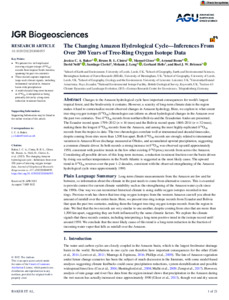The Changing Amazon Hydrological Cycle—Inferences From Over 200 Years of Tree‐Ring Oxygen Isotope Data
Baker, Jessica C.A.; Cintra, Bruno B.L.; Gloor, Manuel; Boom, Arnoud; Neill, David; Clerici, Santiago; Leng, Melanie J.  ORCID: https://orcid.org/0000-0003-1115-5166; Helle, Gerhard; Brienen, Roel J.W..
2022
The Changing Amazon Hydrological Cycle—Inferences From Over 200 Years of Tree‐Ring Oxygen Isotope Data.
Journal of Geophysical Research: Biogeosciences, 127 (10), e2022JG006955.
https://doi.org/10.1029/2022JG006955
ORCID: https://orcid.org/0000-0003-1115-5166; Helle, Gerhard; Brienen, Roel J.W..
2022
The Changing Amazon Hydrological Cycle—Inferences From Over 200 Years of Tree‐Ring Oxygen Isotope Data.
Journal of Geophysical Research: Biogeosciences, 127 (10), e2022JG006955.
https://doi.org/10.1029/2022JG006955
![[img]](/533329/1.hassmallThumbnailVersion/JGR%20Biogeosciences%20-%202022%20-%20Baker%20-%20The%20Changing%20Amazon%20Hydrological%20Cycle%20Inferences%20From%20Over%20200%20Years%20of%20Tree%E2%80%90Ring.pdf)
|
Text (Open Access Paper)
JGR Biogeosciences - 2022 - Baker - The Changing Amazon Hydrological Cycle Inferences From Over 200 Years of Tree‐Ring.pdf - Published Version Available under License Creative Commons Attribution 4.0. Download (3MB) | Preview |
Abstract/Summary
Changes to the Amazon hydrological cycle have important consequences for world's largest tropical forest, and the biodiversity it contains. However, a scarcity of long-term climate data in the region makes it hard to contextualize recent observed changes in Amazon hydrology. Here, we explore to what extent tree-ring oxygen isotope (δ18OTR) chronologies can inform us about hydrological changes in the Amazon over the past two centuries. Two δ18OTR records from northern Bolivia and the Ecuadorian Andes are presented. The Ecuador record spans 1799–2012 (n = 16 trees) and the Bolivia record spans 1860–2014 (n = 32 trees), making them the longest δ18OTR records from the Amazon, and among the most highly-replicated δ18OTR records from the tropics to date. The two chronologies correlate well at interannual and decadal timescales, despite coming from sites more than 1,500 km apart. Both δ18OTR records are strongly related to interannual variation in Amazon River discharge measured at Óbidos, and accumulated upwind precipitation, suggesting a common climatic driver. In both records a strong increase in δ18OTR was observed up until approximately 1950, consistent with positive trends in the few other existing δ18O proxy records from across the Amazon. Considering all possible drivers of this long-term increase, a reduction in rainout fraction over the basin driven by rising sea surface temperatures in the North Atlantic is suggested as the most likely cause. The upward trend in δ18OTR reverses over the past 1–2 decades, consistent with the observed strengthening of the Amazon hydrological cycle since approximately 1990.
| Item Type: | Publication - Article |
|---|---|
| Digital Object Identifier (DOI): | https://doi.org/10.1029/2022JG006955 |
| ISSN: | 2169-8953 |
| Date made live: | 07 Oct 2022 10:31 +0 (UTC) |
| URI: | https://nora.nerc.ac.uk/id/eprint/533329 |
Actions (login required)
 |
View Item |
Document Downloads
Downloads for past 30 days
Downloads per month over past year


 Altmetric
Altmetric Altmetric
Altmetric